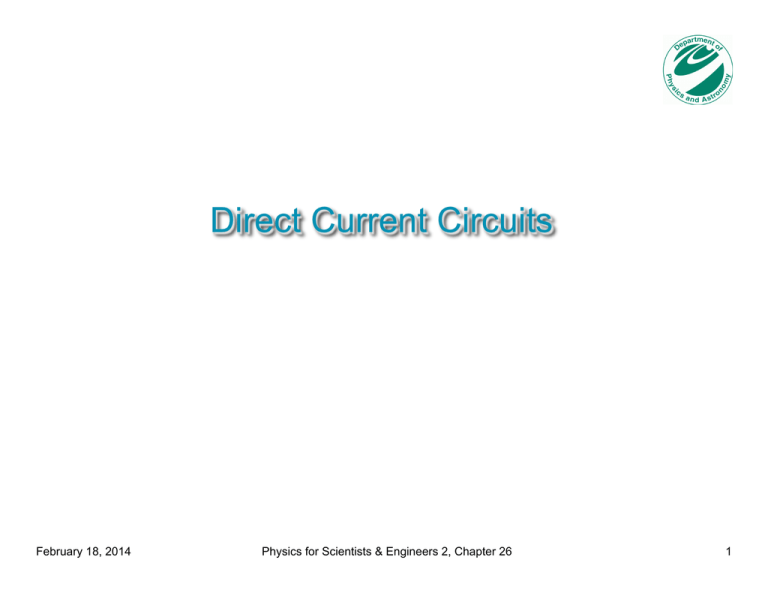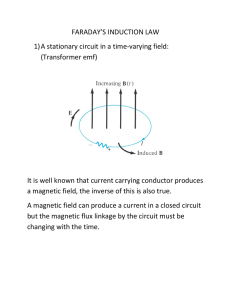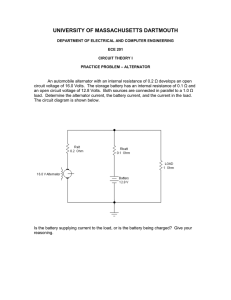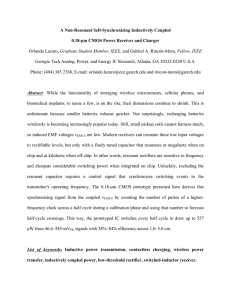Document
advertisement

Direct Current Circuits February 18, 2014 Physics for Scientists & Engineers 2, Chapter 26 1 Kirchhoff’s Junction Rule ! The sum of the currents entering a junction must equal the sum of the currents leaving the junction. n Junction: ∑ ik = 0 k=1 ! A junction is a place in a circuit where three or more wires are connected to each other ! To start, assume direction for each currents: • Positive result: current flows in the assumed direction • Negative result: current flows in the opposite direction February 18, 2014 Physics for Scientists & Engineers 2, Chapter 26 2 Kirchhoff’s Loop Rule ! The potential difference around a complete circuit loop must sum to zero. ! A loop in a circuit is any set of connected wires and circuit elements forming a closed path. ! The sign for voltage sources and resistors depends on the analysis direction and the current direction February 18, 2014 Physics for Scientists & Engineers 2, Chapter 26 4 Kirchhoff’s Loop Rule ! The potential difference around a complete circuit loop must sum to zero. ! A loop in a circuit is any set of connected wires and circuit elements forming a closed path. ! The sign for voltage sources and resistors depends on the analysis direction and the current direction Vemf ,1 − i1R1 + i3 R2 −Vemf ,2 = 0 Vemf ,2 − i3 R2 − i2 R3 = 0 February 18, 2014 Physics for Scientists & Engineers 2, Chapter 26 5 Sign Convention for Potential Changes Element Direction of Analysis Potential Change R Same Current as current Direction -iR (a) Element Analysis Direction Voltage Drop R → → current Opposite to −iR +iR (b) Vemf ← → Same as emf +iR +Vemf (c) Vemf → ← Opposite to emf +iR -Vemf (d) ← February 18, 2014 ← −iR → +Vemf ← −Vemf → −Vemf ← +Vemf Physics for Scientists & Engineers 2, Chapter 26 6 Analysis of Single-loop Circuits ! Choose a direction for the current ! We can determine if our assumption for the direction of the current is correct after the analysis is complete ! Resulting current positive • Current is flowing in the same direction as we had chosen ! Resulting current negative • Current is flowing in the direction opposite to what we had chosen ! We can choose the direction in which we analyze the circuit • Any direction we choose will give us the same information February 18, 2014 Physics for Scientists & Engineers 2, Chapter 26 7 Charging a Battery ! A 12.0 V battery with internal resistance Ri = 0.200 Ω is being charged by a battery charger that is capable of delivering a current of magnitude i = 6.00 A PROBLEM ! What is the minimum emf the battery charger must have to charge the battery? SOLUTION THINK ! The battery charger must have enough potential difference to overcome the potential difference of the battery and the potential drop across the internal resistance of the battery ! The battery charge must be connected so that its positive terminal is connected to the positive terminal of the battery February 18, 2014 Physics for Scientists & Engineers 2 8 Charging a Battery ! We treat the internal resistance of the battery as a resistor in a single loop circuit that contains two sources of emf with opposite polarities ! SKETCH February 18, 2014 Physics for Scientists & Engineers 2 9 Charging a Battery RESEARCH ! We apply Kirchhoff’s Loop Rule ! We assume a current flowing in a counterclockwise direction ! The potential changes around the circuit must sum to zero ! Starting at point b we have −iR1 −Vt +Ve = 0 SIMPLIFY ! We solve this equation for the required potential difference of the charger Ve = iR1 +Vt CALCULATE ! Putting in the numerical values Ve = iR1 +Vt = ( 6.00 A )( 0.200 Ω ) +12.0 V=13.20 V February 18, 2014 Physics for Scientists & Engineers 2 10 Example – Battery Charger V2 " ! Two ideal batteries provide V1=12V and V2=6.0V and the resistors have R1=4.0 Ω and R2=8.0 Ω. (a) What is the current i? V1 − iR2 − iR1 − V2 = 0 i V1 (b) What is the power dissipated in R1 and R2? P1 = (0.5A)2 (4.0Ω) = 1.0W P2 = (0.5A)2 (8.0Ω) = 2.0W February 18, 2014 Physics for Scientists & Engineers 2, Chapter 26 11 Example – Battery Charger (c) Is energy being supplied or absorbed by battery 1 and battery 2? i = +0.5 A " ! Two ideal batteries provide V1=12V and V2=6.0V and the resistors have R1=4.0 Ω and R2=8.0 Ω. V2 V1 For battery 1, the emf arrow points in the same direction as the current: The battery supplies energy to the circuit. For battery 2, the emf arrow points opposite to the current direction: The battery absorbs energy from the circuit, it is being charged! February 18, 2014 Physics for Scientists & Engineers 2, Chapter 26 12 Multi-loop Circuit ! Consider a circuit that has three resistors, R1, R2, and R3 and two sources of emf, Vemf,1 and Vemf,2 ! This circuit cannot be resolved into simple series or parallel structures February 18, 2014 Physics for Scientists & Engineers 2, Chapter 26 14 Multi-loop Circuit ! To analyze this circuit, we need to assign currents flowing through the resistors ! We can choose the directions of these currents arbitrarily ! Junction b gives us i2 = i1 + i3 ! Junction a gives us i1 + i3 = i2 ! Which gives us no new information February 18, 2014 Physics for Scientists & Engineers 2, Chapter 26 15 Multi-loop Circuit ! At this point we have one equation and three unknowns from Kirchhoff’s Junction Rule ! To get the necessary two additional equations we apply Kirchhoff’s Loop Rule ! Start with left half of circuit analyzing the loop in a counterclockwise direction starting at b −i1 R1 −Vemf,1 − i2 R2 = 0 ⇒ i1 R1 +Vemf,1 + i2 R2 = 0 February 18, 2014 Physics for Scientists & Engineers 2, Chapter 26 16 Multi-loop Circuit ! Now analyze the right half of the circuit in a clockwise direction starting at b −i3 R3 − Vemf,2 − i2 R2 = 0 ⇒ i3 R3 + Vemf,2 + i2 R2 = 0 ! We can analyze the outer loop also, but we will not gain any additional information February 18, 2014 Physics for Scientists & Engineers 2, Chapter 26 17 Multi-loop Circuit ! Our three unknowns are i1, i2, and i3 and our three equations are ⎫ ⎧i1 − i2 + i3 = 0 i2 = i1 + i3 ⎪ ⎪ i1 R1 +Vemf,1 + i2 R2 = 0 ⎬ ⇒ ⎨i1 R1 + i2 R2 = −Vemf,1 i3 R3 +Vemf,2 + i2 R2 = 0 ⎪⎭ ⎪⎩i2 R2 + i3 R3 = −Vemf,2 ⎛ 1 ⎜ R ⎜ 1 ⎜⎝ 0 −1 R2 R2 ⎞ 1 ⎞ ⎛ i1 ⎞ ⎛ 0 ⎜ ⎟ 0 ⎟ ⎜ i2 ⎟ = ⎜ −Vemf ,1 ⎟ ⎟⎜ ⎟ R3 ⎟⎠ ⎝ i3 ⎠ ⎜⎝ −Vemf ,2 ⎟⎠ ! Use Cramer’s Rule to get i1 i1 = 0 −Vemf,1 −1 R2 1 0 −Vemf,2 R2 R3 1 R1 −1 R2 1 0 0 R2 R3 R2 + R3 )Vemf,1 − R2Vemf,2 −R2Vemf,1 + R2Vemf,2 − R3Vemf,1 ( = =− R2 R3 + R1 R2 + R1 R3 R1 R2 + R1 R3 + R2 R3 ! Can do the same for i2 and i3 (in the book) February 18, 2014 Physics for Scientists & Engineers 2, Chapter 26 18 Math Reminder: Cramer’s Rule February 18, 2014 Physics for Scientists & Engineers 2, Chapter 26 19 Ammeters and Voltmeters ! A device used to measure current is called an ammeter ! A device used to measure potential difference is called a voltmeter ! To measure the current, the ammeter must be placed in the circuit in series Voltmeter in parallel High resistance ! To measure the potential difference, the voltmeter must be wired in parallel with the component across which the potential difference is to be measured February 18, 2014 Physics for Scientists & Engineers 2, Chapter 26 Ammeter in series Low resistance 22




